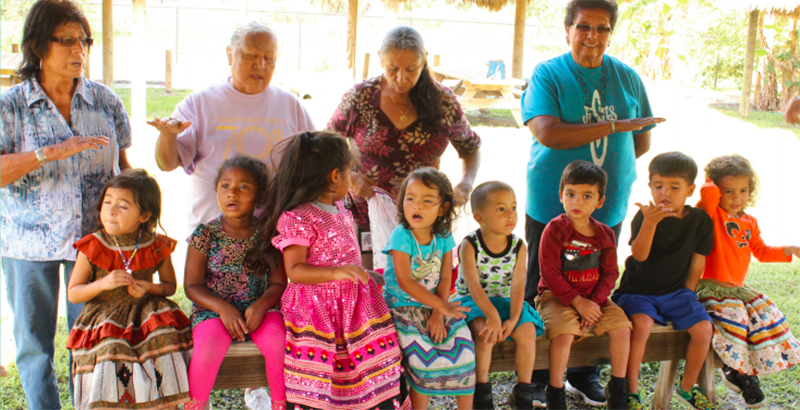New Help for Native American Students: How to Rethink School Design and Culturally Relevant Classrooms for the Next Generation

This article was produced in partnership with LA School Report
Native American students’ unique needs for too long have been poorly served, but culturally relevant charter schools could help change that. And the federal government is poised to fund their expansion.
A new handbook on how to open and sustain charter schools for these students shows how charters can work with Native communities to make sure their culture and traditions are included in the classroom through challenging coursework.
The National Indian Education Association this month released its first Native Community Schools handbook, “Sovereignty in Education: Creating Culturally Based Charter Schools in Native Communities.” It provides an overview of how to start charter schools with strategies and examples of innovation that fit the academic and cultural needs of Native Indian students. It was funded by the Walton Family Foundation.
And new federal funds may be available to open charters in Native communities. Last month, the Department of Education published a federal notice proposing new grants to support charters for underserved student groups, including Native Americans.
“Charter schools also allow Native people the freedom to tailor education as they see fit, including integrating language and culture into educational experiences, and refocusing on specific learning needs of Native students,” Anna Nicotera, National Alliance for Public Charter Schools’ senior director of research and evaluation, noted in the handbook.
“Our communities are capable and able to provide for the education of their citizens – charter schools are one option for them to utilize, and we’re happy to provide them foundational knowledge,” association president Jolene Bowman said in a news release about the handbook. “Our students do best when they see themselves reflected in the classroom and in their curriculum, any opportunity that can make this a reality for them is critical.”
Only 1 in 4 schools on Native American reservations overseen by the Bureau of Indian Education met state proficiency standards in 2013, and students at those schools performed lower than their peers in traditional schools. That federal agency oversees about 182 schools serving roughly 48,000 students at reservations across the United States.
The challenges for educating Native students include finding qualified teachers who understand the culture and sovereignty of Native lands, said Ahniwake Rose, executive director of the association and moderator of the panel “Data & Accountability: Education in Indian Country” at the National Association of Hispanic Journalists’ annual convention last month in Miami.
“We face the same problems finding qualified teachers as rural areas, but they are exacerbated in deep Indian country,” she said. The authors of the handbook “are trying to put together best practices for teachers who might be afraid of teaching the wrong thing, who don’t know what subjects are taboo or even that there are certain times of year when you can’t teach certain topics. The association is trying to work on professional development for teachers in Native American schools and pairing them with tribal mentors.”
At the panel, the issue of sovereignty was discussed as key, giving communities full control and jurisdiction over charter schools so they reflect the history, culture, language, and customs of the specific tribe. That means finding authorizers willing to work under those circumstances, Rose said. And because each community’s needs are so unique, high-performing charter management organizations such as KIPP or IDEA that successfully serve disadvantaged students in other settings may not be the best fit for this specific population.
After the panel, Rose said the challenges are as basic as the fact that some of the states with the largest Native American populations, like North and South Dakota, have no charter laws. According to the National Charter School Resource Center, 42 states authorize charter schools; eight do not.
The handbook points out that charters can be built around the Native identity. The association “supports Native charter schools as they seek to integrate Native knowledge, culture, language, and other aspects of identity into the classroom,” it says.
In California, the state with the largest number of charter schools in the nation, Native American students represent 0.6 percent of all students attending charter schools. California also has more Native Americans than any other state, more than 360,000, according to the most recent Census data. And soon, Native California studies could be part of statewide curriculum.
In October, Gov. Jerry Brown signed AB 738, legislation that requires the state Board of Education to create a Native American studies class curriculum for high schools that will satisfy the elective course requirements for admission to the University of California and California State University schools. Brown also signed AB 2016, which creates an elective high school ethnic studies course that could include Native American history and culture. The state Board of Education is required to adopt the ethnic studies curriculum by March 2020.
The association’s handbook lays out how Native communities can build, manage, and expand charter schools that effectively serve their students.
It also highlights several strong Native charter schools, including Pemayetv Emahakv Charter School, on the Brighton Seminole Indian Reservation in Okeechobee, Florida, for its rigorous curriculum infused with Seminole language and culture, in an environment designed to preserve Seminole traditions.
Brian Greseth, the school’s principal and a panelist at the Miami conference, noted that one of the school’s fourth-grade math teachers, Joy Prescott, was just named Florida’s Teacher of the Year. He said 80 percent of her students scored proficient on the Florida Standards Assessments math test, compared with 50 percent statewide, “but it’s not just standardized tests,” he said. “The kids love her.”
Executive Editor Kathy Moore contributed to this report.
Disclosure: The Walton Family Foundation provides financial support to The 74.
Get stories like these delivered straight to your inbox. Sign up for The 74 Newsletter

;)
